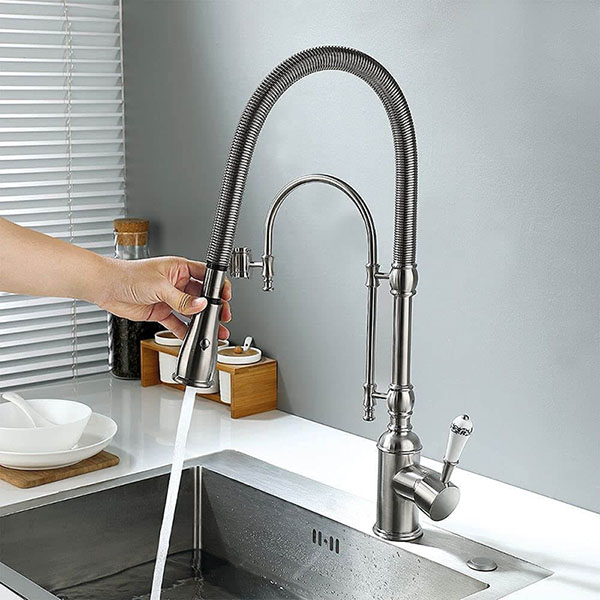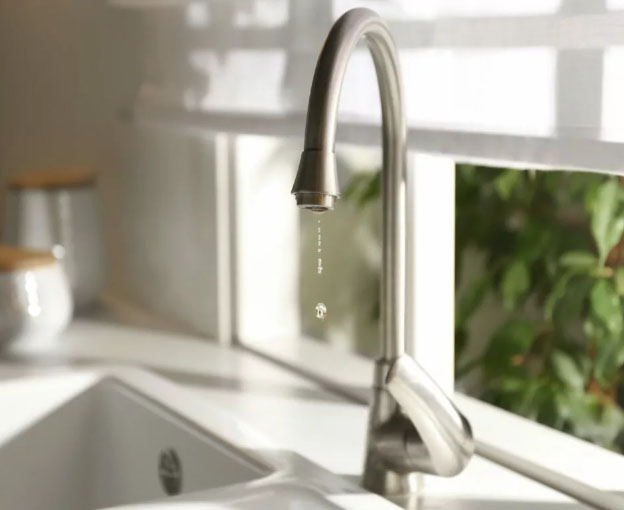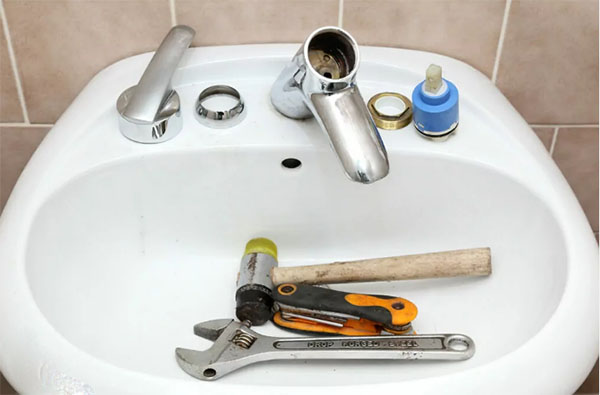Introduction
A well-functioning kitchen faucet is an essential component of any household. It ensures a seamless flow of water for cooking, cleaning, and other domestic tasks. The pull-down kitchen faucet with sprayer is a very simple fixture. Compared with the traditional faucet, the popular pull-down kitchen water hose in recent years has solved the sanitary problem of not being able to remotely rinse kitchen utensils. However, when a pull-down kitchen faucet leaking at handle , it can lead to a host of issues, including water wastage, potential damage to the surrounding area, and an increase in water bills. Now, we will delve into the common causes of this problem and explore step-by-step solutions to rectify it.
Understanding the Anatomy of a Pull-Down Kitchen Faucet

Arcora Single Handle High Arc Swiveling Dual Mode Sprayer Kitchen Sink Faucet
Before diving into troubleshooting, it’s important to have a basic understanding of how a pull-down kitchen faucet works. A typical pull-down faucet consists of several components:
- Handle: This is the lever you use to control the flow and temperature of the water.
- Spout: The spout is the part of the faucet from which water flows.
- Spray Head: The spray head is detachable and allows for flexible water flow options, such as stream or spray.
- Hose and Weight: The hose connects the faucet to the water supply, while the weight helps the spray head retract smoothly.
- Cartridge or Valve: This is the internal mechanism that regulates the water flow and temperature.
- O-rings: These are small, round rubber or silicone seals that are used to create a watertight seal between moving parts in a faucet. They are often used to seal connections between the faucet’s spout and the body, as well as in handles to prevent water from leaking out around the stem.
- Washers: In traditional compression faucets (which are less common nowadays), washers are used to form a seal between the faucet’s valve seat and the stem. When you turn the handle, it moves the stem up and down, compressing or releasing the washer to control the flow of water.
Common Causes of A Pull-Down Kitchen Faucet Leaking Faucet At Handle
When a pull-down kitchen faucet leaking at the handle, it can be attributed to a variety of underlying issues. Here are some of the most prevalent causes:
1. Worn Out Cartridge
The cartridge is a crucial component in a faucet that controls the flow and temperature of water. Over time, the cartridge or valve inside the faucet may wear out, leading to problems like leaks, low water pressure, or difficulty in adjusting water temperature. This is especially common in older faucets that have seen a lot of use.
2. Loose Handle
In the context of a faucet, a loose handle means that the part of the faucet you use to turn the water on and off is not firmly attached or it moves excessively when you try to operate it. A loose handle can be a minor annoyance or a potential source of a larger issue, especially if left unattended. It’s generally a good idea to address this problem promptly to prevent further damage and ensure the proper functioning of the object. This can be caused by various factors, including:
- Frequent use can cause the handle to become loose, which can create gaps that allow water to escape.
- The screws or nuts that hold the handle in place may have become loose due to regular use or vibration.
- If the faucet was not installed correctly, it can lead to a loose handle.
- Corrosion or mineral deposits can weaken the connections and cause the handle to become loose.Corrosion or mineral deposits can weaken the connections and cause the handle to become loose.
- In some cases, there may be a defect in the handle or other parts of the faucet that causes it to become loose.
3. Faulty O-Rings or Washers
O-rings and washers form a seal to prevent water from leaking. Over time, O-rings and washers can become worn, cracked, or flattened due to regular use, exposure to water, and temperature fluctuations. When these components become worn or damaged, they can no longer create an effective seal.

4. Corroded Parts
Faucet corrosion occurs when metal components, exposed to water and air, degrade over time. Water with high mineral content leads to rust, tarnish, and weakened structural integrity. Corroded parts can cause leaks, reduced water flow, and ultimately, faucet failure. Regular maintenance and replacement of corroded components are crucial for a faucet’s longevity and performance.
5. Improper Installation
Improper installation refers to the incorrect or flawed setup of a system, appliance, or component. It results from mistakes in assembly, positioning, or connection. This can lead to malfunctions, safety hazards, and reduced efficiency. Proper installation is crucial for ensuring optimal performance and longevity of the installed item.
Step-by-Step Guide to Fixing A Pull-Down Kitchen Faucet Leaking At Handle
Now that we have identified the common causes, let’s proceed with a step-by-step guide to fixing a pull-down kitchen faucet that is leaking at the handle.
1. Gather the Necessary Tools
Before starting any plumbing project, it’s crucial to have the right tools on hand. For this task, you will likely need:
- Adjustable wrench
- Screwdrivers (both flathead and Phillips)
- Plumber’s tape
- Replacement parts (cartridge, O-rings, washers, etc.)
- Bucket or towel to catch excess water
2. Turn Off the Water Supply
Locate the shut-off valves beneath the sink and turn them clockwise to shut off the water supply. If your kitchen faucet doesn’t have individual shut-off valves, you may need to turn off the main water supply for your home.
3. Disassemble the Faucet
Using a screwdriver, carefully remove the handle. Depending on the faucet model, there may be a decorative cap covering the screw. Once the handle is removed, you should have access to the internal components.
4. Inspect and Replace Components
Check for any visible damage or wear on the cartridge, O-rings, washers, and other components. If you notice any issues, replace them with new parts.

5. Apply Plumber’s Tape
If you’ve replaced any components, apply plumber’s tape to the threads to ensure a tight seal.
6. Reassemble the Faucet
Carefully reassemble the faucet in the reverse order of disassembly. Make sure all components are securely in place.
7. Turn On the Water Supply
Gradually turn on the water supply and check for any leaks. If you notice any, try tightening the components further.
8. Test the Kitchen Faucet
Test the kitchen faucet by turning it on and off, checking for any unusual sounds or signs of leakage. If everything looks good, you’ve successfully fixed the issue!
Conclusion
A pull-down kitchen faucet leaking at handle can be a frustrating problem, but armed with the right knowledge and tools, it’s a fixable issue for most homeowners. By understanding the anatomy of the faucet and following a step-by-step guide, you can address the problem efficiently and prevent further water wastage. Remember, regular maintenance and prompt repairs are key to ensuring the longevity and functionality of your kitchen faucet.
 ARCORA FAUCETS
ARCORA FAUCETS